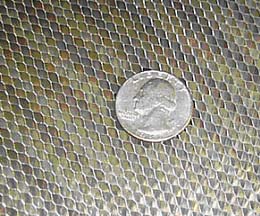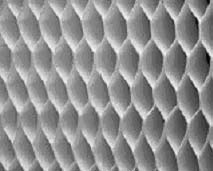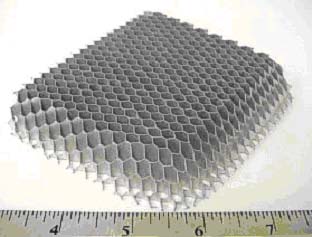

ALUMINUM HONEYCOMB

Honeycomb is predominately used as a core in sandwiched structures to meet design requirements for highly stressed structural components. When sandwiched between layers of carbon fiber, honeycomb exhibits extreme resistance to shear stresses. As a structural core material, it is used in all types of aerospace vehicles and supporting equipment where sandwich structure offers rigid panels of minimum weight, aerodynamic smooth surfaces, and high fatigue resistance. The same structural properties are also used for commercial applications such as tools, snow and water skis, bulkheads, and floors. Honeycomb is also used where designs need a means of directional air/fluid flow control and/or energy absorption.
As previously stated, the active beds of the RCRS are pressurized and full of
hot air, and the inactive beds above and below the active bed are exposed to
cold space vacuum. The pressure gradient caused tends to force the walls dividing
the beds to bend. This bending subjects the structures housing the solid amine
beads to compressive forces. Therefore, we want take advantage of the high strength
and rigidity to weight ratios, airflow control ability, and energy absorption
rates found in aluminum honeycomb. By using the honeycomb to house the chosen
medium of solid amine, the beds will be much less subject to bending and compressive
forces during operation, making the design much more structurally sound. Being
made of perforated aluminum, the honeycomb structure will also be effective
in transferring heat from the hot active beds out to the cool walls that separate
the active and inactive beds.
Coeus Engineering is currently researching different properties of various types and sizes of aluminum honeycomb. For carbon nanotube structures, the honeycomb cell size will have to be very small, making the overall design somewhat heavy. Therefore, other materials, such as VersaCore or other composites, may be preferable for the honeycomb structure housing this particular solid amine medium. However, aerogels are of a more applicable size, and can be easily shaped inside honeycomb structures with rather large cell sizes (approximately 0.25"- .375"). This would make for a relatively strong and lightweight design.


SITES TO CHECK OUT ON HONEYCOMB:
http://www.teklam.com/teklam_aircraft_grade_panels.html
http://www.hexcelcomposites.com
http://www.versacoreindustrial.com/The_Material/the_material.html